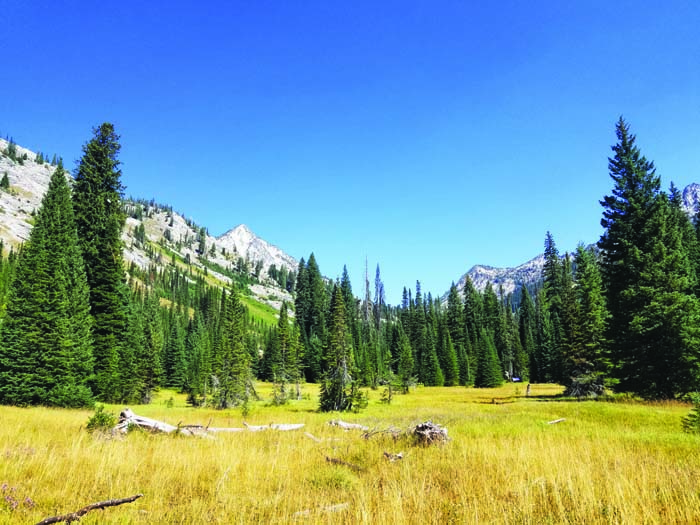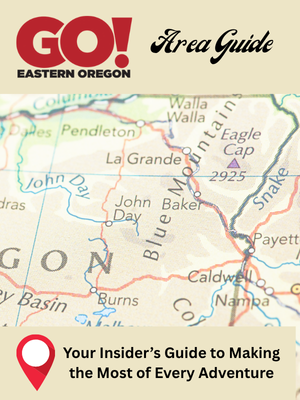Forest Service trying to contain, rather than monitoring, fire in Eagle Cap Wilderness
Published 9:07 am Monday, August 19, 2024

- The alpine meadow along Eagle Creek is a classic mountain field, with tawny grass, thickets of spire-shaped subalpine firs, and a backdrop of the granitic peaks of the Eagle Cap Wilderness. The tallest summit in the area, in the middle left of the photo, is Needle Point, elevation 9,018 feet. A wildfire is burning southwest of the meadow, in the Boulder Creek area.
The Wallowa-Whitman National Forest is treating a fire in the Eagle Cap Wilderness as a regular wildfire rather than monitoring the blaze and allowing it to burn, as was the case with more than two dozen lighting-sparked fires in the wilderness over the past quarter century.
“We briefly considered letting the Boulder Creek Fire continue for resource benefit but in context with the fire season we have had this year, my decision was to treat this start as a full suppression fire even in the wilderness,” Wallowa-Whitman Supervisor Shaun McKinney said on Monday morning, Aug. 19. “We continue to follow this strategy with the weather forecast, resources available and most importantly firefighter safety in the forefront of our thinking.”
The fire was reported just before 1 p.m. on Sunday, Aug. 18. The cause has not been determined.
It is burning near Boulder Creek, a couple miles northwest of Boulder Park in southern Union County, along Eagle Creek. The fire was estimated at 150 acres on Monday morning.
There are no evacuation orders, or forest area closures, due to the fire. However, the fire could affect the Fake Creek Trail, according to the Wallowa-Whitman.
Buzz Harper, chief of the Keating Rural Fire Protection District, said the fire on Sunday evening was torching pockets of subalpine fir trees.
Subalpine fir trees, which typically grow above about 6,000 feet elevation, can burn readily, as they usually have limbs growing at ground level. The trees also have high levels of sap that makes the trees susceptible to torching.
Nine firefighters who rappelled from a helicopter are working on the fire, which is in the extremely steep terrain typical of the Eagle Cap Wilderness, and making access on the ground difficult. Aircraft are also dropping retardant, said Walter Lowell, public affairs officer for the Wallowa-Whitman.
Elsewhere on the forest, fire crews have made good progress in containing the 22.5-acre Lyle Fire, west of Camp Creek and north of Whitney. That fire was started by lightning.
A 1-acre fire just to the north of the Lyle Fire was human-caused.
History of lightning fires in the Eagle Cap
Starting in the early 1990s, the Wallowa-Whitman has taken a different approach to many lightning-sparked blazes in the Eagle Cap Wilderness compared with the usual goal to contain blazes as soon as possible.
Forest officials say the unique conditions in the Eagle Cap, Oregon’s largest federal wilderness at 365,000 acres, make it feasible to employ the strategy known as “wildland fire use.”
The basic idea is to allow lightning fires to burn naturally in the wilderness so long as the fires don’t threaten public safety or private property.
Forest officials say fires are a natural process in the wilderness, and that quickly dousing all fires could allow unusually large amounts of fuel to accumulate in the wilderness.
Allowing lightning fires to burn naturally is more practical in the Eagle Cap due to its size, and to the amount of rocky terrain devoid of vegetation that serves as natural firebreaks.
Although many of these monitored fires have been relatively small, covering fewer than 50 acres, during the summer and fall of 2022 the Sturgill Fire burned about 21,000 acres in the northern part of the Eagle Cap, producing massive “pyrocumulus” clouds from its intense heat in late August and early September of that year, and the Nebo Fire burned 12,600 acres on the east side of the wilderness. Firefighters did take some action to slow the spread of those fires, but they didn’t use the “full suppression” tactics that the Forest Service uses for blazes outside the wilderness.
Wildland use fires are allowed only in the Eagle Cap. The Forest Service doesn’t use the tactic in other federal wilderness areas in the region.








